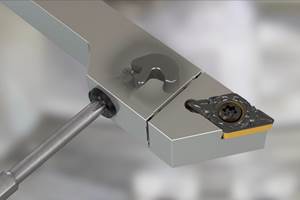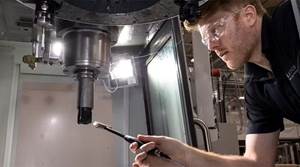Indexable Cutters Prove Versatile Choice For Contoured Surfaces
Robert Pinto had always cut that external radius with a form tool. It seemed the most efficient way.
Share





Robert Pinto had always cut that external radius with a form tool. It seemed the most efficient way. With a pass or two, the entire form was complete, and it was as accurate as the combination of the machine and the last tool grind could produce. But when Mr. Pinto began to look at that operation in the larger context of the complete machining process--as well as the shop's ability to support it--he quickly changed his mind. Standard indexable tools with more versatile cutting capabilities proved to be the better choice, and for a number of reasons.
Part of the issue has to do with the new competitive realities of the machined parts market. Pinto Associates is a small job shop in Glastonbury, Connecticut, that for years had been heavily focused on serving the aerospace industry. As that business grew increasingly tenuous over time, the shop gradually shifted the mix toward the commercial customers who now account for the majority of the work. Pinto has retained its qualitative standards, however, and they still define the shop's niche. "We produce aircraft quality for the commercial market," says Mr. Pinto, so cutting corners simply for the sake of expediency will not do.
Still, as the shop has moved into the price-competitive commercial sector they have had to become more efficient at the same time they have learned to deal with the just-in-time demands of their customers. "JIT makes you analyze how you do everything," says Mr. Pinto, and the more he thought about using special tooling, the more he realized it was costing too much in both time and money for the low-lot, high-mix environment of his job shop. "I'm always thinking about what's going to stop me," he says, meaning something that is going to abruptly bring a process to a halt, or prevent it from proceeding in the first place. And by Mr. Pinto's reckoning, the potential unavailability of a special tool far outweighs the benefit of quickly generating a single feature on a part--if, that is, he can find a standard tool to suitably do the same job.
Pinto found just that in the case of the radius cut for a job the shop does on a repeating basis for a customer in the professional audio components business. The workpiece is a contoured aluminum face plate that is machined to form, and then surface grained and blackened for the sake of aesthetic appearance. It was the radius at the ends of the plates that were being generated with the form tools. And occasionally, when one of those tools went dull or broke unexpectedly, they'd have to shut down the process for the lack of a suitable replacement. The tools were too expensive to have many extras on the shelf, and too often machine time was wasted or a delivery was put in jeopardy.
To replace the form tool, Pinto went to an indexable profiling cutter from Millstar LLC (Bloomfield, Connecticut). The Millstar approach is to use insert type cutters where solid tools have traditionally reigned, and the line includes indexable ball-nose, flat-bottom and back-draft cutters ranging from 1/4 to 1¼ inch in diameter.
In Pinto's case, the appropriate choice was an indexable ball-nose cutter. While it did indeed free the process from the availability of special tools, the tool has provided other advantages as well. For one, the entire workpiece can be machined with fewer tools. Besides generating the radii on either end of the workpiece, the same ball nose cutters are used to generate every contour on the workpiece.
The tools also provide better control over the cutting process overall. The use of inserts allows more sophisticated geometry to be formed or ground into the cutting edge than can typically be achieved with solid body cutters, and practically speaking, provide a wider choice of cutter material grades and coatings. Pinto uses a positive ground chipbreaker design for the aluminum, but strong negative cutting edges are also available. And while Pinto has been using a TiN coating for this piece, they can choose from a range of PVD and CVD thin-film coatings for other applications.
These particular inserts help Pinto change worn tools faster. Regrinds are no longer an issue, of course, since they just replace inserts when an edge is dull. But there is also no need to re-establish tool edge location after such a change. With reground tools--or with standard tolerance indexable tools for that matter--the edge location is typically going to change enough from tool to tool that it is necessary to reset the tool offsets each time an edge is changed. With the Millstar design, however, the ground inserts are seated in a V-shaped pocket in the cutter body. The hole in the insert functions not as a location device, but more as a cam-like mechanism by which the insert is driven firmly and positively into the seat. As such, the manufacturer says that insert location is accurate to +0.00025 inch of nominal radius, which means that Pinto typically need not adjust their offsets at all when an insert is changed.
The insert is supported on both sides by the cutter body, and tightly "sandwiched" as the locking screw is tightened. This prevents insert movement when milling with side thrust, and generally serves to provide a rigid cutting edge.
For Pinto, it all adds up to the ability to cut more aggressively than before, yet still achieve better finishes. To further enhance the finish, as well as accuracy and tool life, they take each finish pass in the same direction, about 0.003 inch apart, and always with a climb-milling cut. While the uni-directional cutting does add some amount of "air time" to the cycle, Mr. Pinto says that the faster feeds more than make up for it. In fact, the total workpiece cycle time is actually less than prior process with form tools, and the overall surface finish is considerably improved as well.
As it now stands, Pinto is making these parts better than ever before. Direct costs are lower since new inserts are far less expensive than new form tools, or regrinds for that matter. But most comforting to Mr. Pinto's business sense, he no longer has to worry about running out of tools. He can afford to stock as many inserts as he wants, and when he has to buy more, he just gets them off the shelf. MMS
Related Content
Quick-Change Tool Heads Reduce Setup on Swiss-Type Turning Centers
This new quick-change tooling system enables shops to get more production from their Swiss turning centers through reduced tool setup time and matches the performance of a solid tool.
Read MoreShop Reclaims 10,000 Square Feet with Inventory Management System
Intech Athens’ inventory management system, which includes vertical lift modules from Kardex Remstar and tool management software from ZOLLER, has saved the company time, space and money.
Read MoreShoulder Milling Cuts Racing Part's Cycle Time By Over 50%
Pairing a shoulder mill with a five-axis machine has cut costs and cycle times for one of TTI Machine’s parts, enabling it to support a niche racing community.
Read MoreHow to Mitigate Chatter to Boost Machining Rates
There are usually better solutions to chatter than just reducing the feed rate. Through vibration analysis, the chatter problem can be solved, enabling much higher metal removal rates, better quality and longer tool life.
Read MoreRead Next
AMRs Are Moving Into Manufacturing: 4 Considerations for Implementation
AMRs can provide a flexible, easy-to-use automation platform so long as manufacturers choose a suitable task and prepare their facilities.
Read MoreMachine Shop MBA
Making Chips and 91ÊÓƵÍøÕ¾ÎÛ are teaming up for a new podcast series called Machine Shop MBA—designed to help manufacturers measure their success against the industry’s best. Through the lens of the Top Shops benchmarking program, the series explores the KPIs that set high-performing shops apart, from machine utilization and first-pass yield to employee engagement and revenue per employee.
Read More





















